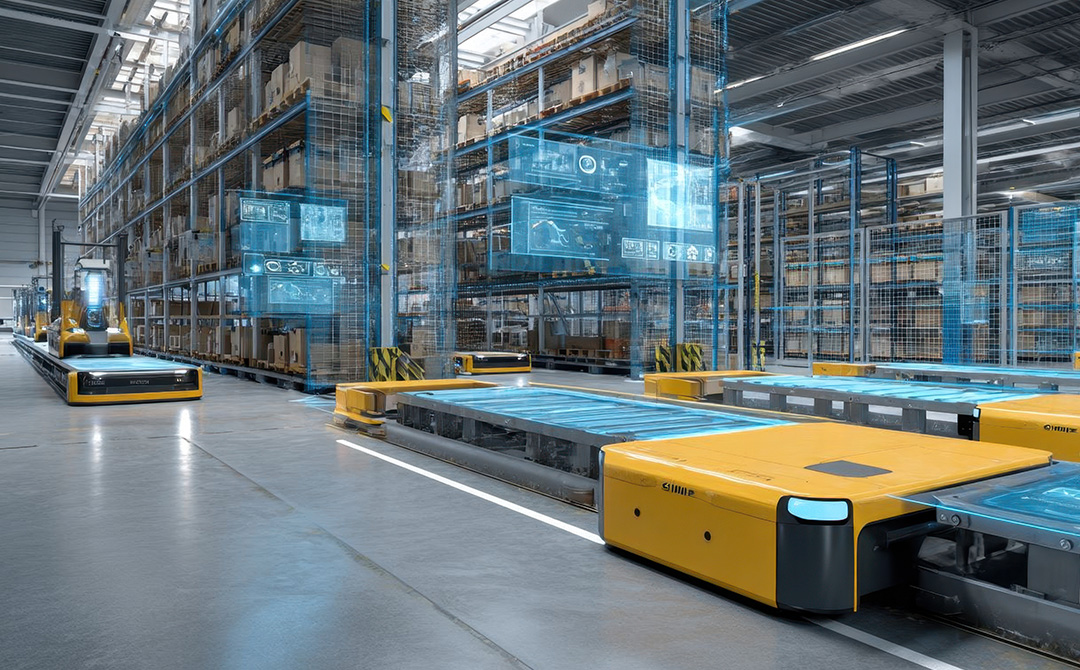
What if your warehouse could outthink and outpace your competition - all thanks to AI?
Imagine a fulfillment operation so smart that it anticipates demand spikes, optimizes inventory placement in real-time, and accelerates order fulfillment with tip-top accuracy. That’s exactly what AI warehouse optimization achieves. And as a supply chain leader, this is an angle you could look into for dominating supply chains.
Right now, this concept is no longer futuristic. It’s your strategic blueprint for transforming every step of your fulfillment journey. So, let’s dive in and explore everything you need to know about AI-powered warehouse optimization and how it can give your business an agile advantage in the market!
What Is Warehouse Optimization? Defining Efficiency & Throughput
Simply put, warehouse optimization is the systematic and disciplined process of enhancing warehouse operations with the main goal of reducing costs, improving speed, maximizing space utilization, and improving overall productivity. It involves strategic planning, from general operations and layout to managing relevant workflows and technologies used to boost efficiency in warehouse inventory management.
There are two core parameters to analyze the performance of warehouse operations:
- Efficiency - To enable greater efficiency, you take steps to streamline workflows, eliminate redundant activities, consciously inspect for errors, and effectively leverage technologies that are available to you. This all means faster order processing, lower labor costs, and improved safety for warehouse workers. Common KPIs to measure efficiency include order lead time, error rate, return rate, and cost per location per piece.
- Throughput - This basically refers to the volume of goods processed or moved through the warehouse at any given time frame. A higher throughput translates to higher order fulfillment and the ability to handle bulk orders without any operational bottlenecks. Order cycle time, inbound/outbound throughput, inventory turnover, and order picking productivity are common KPIs you use to measure throughput.
What is AI Warehouse Optimization: Core Technologies, From Computer Vision to Predictive Analytics
According to a recent study by McKinsey, AI systems have significantly increased picking efficiency by up to 70% in warehouse facilities through the use of intelligent robotics. Order accuracy in AI-supported warehouses also now averages 99.5%, minimizing costly returns. (Source). These numbers are solid proof that embedding AI in warehousing can change the game. And this is supported by a layered blend of technologies like:
Machine learning & predictive analytics
In AI warehouse optimization, the capabilities of machine learning and supply chain predictive analytics go hand-in-hand. While the former analyzes vast historical datasets, the latter forecasts demand from the data to control stock and automate replenishments. Together, they enable proactive management through the reduction of costly stockouts, matching labor availability, and flagging slow-moving SKUs.
Computer vision
In AI warehouse optimization, this is a key technology. It is where AI-powered cameras and sensors perform real-time inventory tracking, detect product damage, and automate scanning. This technology is embedded in autonomous drones as well, where they scan high racks and perform rapid cycle counts.
Autonomous robots
You will not have to continue with basic warehouse activities like picking, packing, and sorting as robots can now perform that work for you. They adapt to order patterns and new layouts readily, while you can divert your attention to high-value warehouse functions.
Dynamic slotting
What if your warehouse executives or workers didn’t have to spend hours or days travelling to pick and deliver goods? AI algorithms are also capable of dynamic slotting, where they constantly re-optimize product placement based on seasonality, order velocity, and SKU relationships. This essentially boosts picking speeds, allowing you to keep up with demand spikes.
Core AI Techniques: Demand Forecasting, Slotting Optimization, Anomaly Detection & Reinforcement Learning
Did you know that there’s more than one technique to apply AI warehouse optimization? If you’re looking to reap the best outcomes from your warehouse operations, then it’s beneficial to understand each technique for better detection of critical issues, adaptability, and innovation:
AI-Driven Warehouse Management Systems: Real-Time Inventory Visibility, Dynamic Replenishment & TMS/WMS Integration
Now, you no longer have to worry about manually gaining inventory visibility or replenishing goods in your warehouse. Thanks to robust AI-powered management systems, you can now modernize logistics operations with the following technologies:
Real-time inventory visibility
Imagine having the convenience of simply scanning an item and immediately receiving details on its location and status, like its delivery or condition. What makes them possible? They’re none other than RFID tags, barcode scanners, and IoT sensors. Additionally, autonomous robots can also create a live digital twin of your warehouse, allowing you to track inventory levels and conditions in real-time.
Dynamic replenishment
Let’s say your warehouse management system (WMS) analyzes sales numbers of the last quarter and automatically triggers restock orders after predicting a demand spike. Ever wondered how it does that? Predictive analytics within these systems forecast inventory needs and real-time demand signals, improving inventory turnover and automating reorder triggers for timely replenishment.
TMS/WMS integration
This signifies the integration of transport management systems with warehouse management systems for effective AI warehouse optimization. The end goal of this is to achieve end-to-end supply chain efficiency. Think of it this way - your orders are packed and ready for shipment, and you wish to know the best carriers and routes to take. With TMS integration, you get the benefits of route optimization and automated data exchange that perfectly align inventory and outbound shipments for on-time, accurate deliveries.
Inventory Placement & Slotting: Heuristic Methods vs. AI-Powered Dynamic Slotting
To achieve higher efficiency and order fulfillment speed in AI warehouse optimization, there are two things you need to give importance to as a supply chain leader: Inventory placement and slotting. The former decides where to store your inventory, while the latter strategically organizes and assigns items to their optimal physical storage locations. Back then, heuristic methods were followed that relied on fixed rules and experience-based guidelines. But now, we have AI algorithms changing the game with real-time placements and slotting. Let’s dig deeper into their distinctions:
|
Basis |
Heuristic Methods |
AI-powered Dynamic Slotting |
|
Complexity |
Easier to implement and explain. |
Highly complex; requires specialized expertise and infrastructure. |
|
Result Consistency |
Consistent, but potentially suboptimal. |
Potentially better outcomes that vary based on model quality and data integrity. |
|
Data usage |
Usage is limited, based on historical averages. |
Usage is extensive, involving large datasets. |
|
Cost |
Comparatively lower, but it may lead to inefficiencies. |
Requires higher initial investment with potential for higher efficiency and greater ROI. |
|
Scalability |
Limited; it’s less effective in large or complex warehouses. |
Highly scalable and effective for complex, high-volume operations. |
Order Picking & Path Optimization: Voice Picking, Pick-to-Light, Goods-to-Person & Robot-Assisted Picking
Simply known as Pick path optimization, this concept identifies the most efficient routes through a warehouse, so order pickers can reduce travel distances and complete orders faster. As a supply chain leader, there are four game-changing methods to go about this:
- Voice picking - Powered by audible instructions, pickers can do their job hands-free and faster with fewer errors. And most of all, they won’t get lost in the way thanks to voice instructions guiding them.
- Pick-to-light - Imagine the amount of time you can save, instantly seeing what to pick next. This method uses light signals, guiding pickers to the exact item locations, reducing picking errors.
- Goods-to-person - Ever thought about how many deliveries you could execute without the daily walk times? With automated systems, you deliver items to stationary pickers, slashing travel times and possibly increasing delivery capacities.
- Robot-assisted picking - What if robots did the heavy-lifting in your warehouse while you focused on strategy and other high-value tasks? This is now entirely possible with robotic picking systems, working alongside your staff to automate repetitive tasks, transport picked goods, and execute pick-and-place.
Autonomous Mobile Robots & Automation: AGVs, AMRs & AI-Orchestrated Fleet Management
Warehousing isn’t just about inventory management and timely deliveries. It’s also about understanding how machines move around the facility without causing any operational disruptions. Whether it's robots or vehicles, they need perfect synchronization to prevent any “traffic jams” within the warehouse. That’s where you exploit the power of automation in the form of:
- Automated guided vehicles - AGVs are the ideal workhorses, built to follow fixed paths using magnets, tracks, or sensors. They are dependable for predictable, repetitive warehouse tasks like pallet transfers between storage areas and loading docks. A few examples include forklift, counterbalance, towing, and unit load AGVs.
- Autonomous mobile robots - AMRs are just ordinary robots - they’re agile problem solvers, designed to navigate warehouses dynamically. Just like how a GPS adjusts routes due to road closures, AMRs can reroute in real-time if an aisle is blocked. They are also highly instrumental in e-commerce fulfillment, being able to flexibly handle picking and sorting across zones.
Automation can do a lot of things. But in the end, it’s not the same as orchestration. And as a supply chain leader, he’s the prime question you need to ask yourself: What happens when you deploy dozens, if not hundreds, of these machines all at once?
That’s where we bring AI-orchestrated fleet management into the conversation. Imagine all your robots being directed as a unit through a command center that coordinates, routes and tasks fleet-wide.
This can be a critical aspect of your AI warehouse optimization measures, from dynamic task allocation for each robot to predictive scheduling and interoperability between AGVs and AMRs.
AI for Warehouse Layout & Space Utilization: Digital Twins, Simulation & Continuous Layout Refinement
As a supply chain leader, you may have faced the frequent challenge of fitting more inventory or with slow picking routes. As part of your AI warehouse optimization strategies, it’s important to look into your warehouse layout and ensure timely adjustments are made so your warehouse space can evolve and adapt to growing demand and operational changes. There are three ways to do that:
- Digital Twins - The market for digital twin technology is set to witness significant growth at a CAGR of 40.1% from 2025 to 2032. (Source) This number is a testament to this technology’s increasing use in multiple industries, even in warehouses. The way it works is simple - it creates a virtual replica of your warehouse, allowing you to visualize and optimize your warehouse without causing any downtime.
- Continuous layout refinement - Warehouse space requirements don’t always stay the same. They may change due to factors like demand spikes, changing inventory profiles, and seasonality. These factors will demand incremental layout changes, ensuring operations scale without massive overhauls.
Quality Control & Inspection: Computer Vision for Defect Detection, Automated Sorting & Compliance Checks
The importance of quality control and inspection regarding AI warehouse optimization cannot be stressed enough if you wish to make sure that products meet the customer and company standards. But manual quality checks can be time-consuming and a hassle, especially if you’re looking into high stock volumes. But what if there were a system that could do just that for you? This is where we bring computer vision into the picture for the following:
Defect detection
In AI warehouse optimization, computer vision uses advanced image recognition to spot minute product defects like scratches, mislabels, or packaging flaws as they move down the production line. It can dramatically reduce inspection times and defect escape rates, keeping product quality uncompromised.
Automated sorting
Computer vision doesn’t just detect defective products. It can even separate them from the perfect ones. This reduces manual handling and speeds up production lines.
Compliance checks
Compliance is key in every industry and there’s no exception, even for AI warehouse optimization. Here, computer vision ensures every product conforms to regulatory and customer-specific requirements by verifying labels, barcodes, and packaging conditions.
AI in Demand Forecasting & Replenishment: Machine Learning Models for Seasonal & SKU-Level Planning
According to a McKinsey report, 92% of executives around the world intend to make considerable investments in AI by 2028. And its use in demand forecasting is one of the major reasons driving the rise in investment. (Source) For years, this technology has been changing the game, especially in handling seasonal complexities and SKU-level planning.
For instance, when we look at machine learning models, they dig deep into large datasets, from historical sales figures to real-time signals like social media buzz, current market trends, economic shifts, etc. As a supply chain leader, it means you get more organic and accurate forecasts at a granular level - down to each SKU - helping you prevent overstocking and accelerate replenishment of goods to meet demands anytime.
Integrating AI with Enterprise Ecosystems: ERP, IoT Sensor Networks & Analytics Dashboards
As part of your AI warehouse optimization strategy, integrating this technology with enterprise systems like ERP, IoT sensor networks, and analytics dashboards can change the game big time. Think of AI as a smart engine that connects all these pieces to break down data silos and unlock real-time warehouse insights. Let’s start with your ERP systems, for example. Integrating AI with this tool automates routine tasks like inventory management, allowing you to focus on strategic decision-making.
Add IoT sensor networks into the mix, and they constantly feed your AI systems with live data from warehouses, vehicles, and production lines. And of course, you’d need full visibility into all insights generated, which is facilitated by analytics dashboards. With this integration, you don’t react to problems - you anticipate them, adding resilience to supply chain operations and making the right decisions for AI warehouse optimization.
Challenges in Implementation: Data Quality, Legacy System Integration, Change Management & Scalability
AI warehouse optimization can be beneficial in many ways, but not without some prevailing challenges:
- Data quality - Poor data quality leads to wrong insights and predictions that end up in costly warehouse errors and delivery delays. AI systems depend on accurate and consistent data for more accurate predictions and seamless warehouse operations.
- Legacy system integration - AI warehouse optimization can be a major challenge when you’re still dealing with outdated systems. Integration between such systems is not only expensive but also highly complex and leaves them open to security threats. This demands a smooth and proper data flow between new and existing systems - or better yet, upgrading to new, AI-powered systems.
- Change management - Successful adoption of AI in warehouse operations must start from the C-suite level. It’s not just about acceptance of AI, but also about workforce buy-in through clear communication, training, and eliminating resistance to change.
- Scalability - Warehouse solutions must be flexible enough to scale during demand spikes and growth phases without expensive overhauls. Scalability, in this case, is a challenge if your systems aren’t properly updated or built to handle future business requirements or changes.
Best Practices for Deployment: Pilot Phases, Agile Iterations, Feedback Loops & Continuous Optimization
The implementation stage in AI warehouse optimization isn’t as simple as flipping a switch. It requires a complete understanding of your tech stack, building trust in that tech stack, and making sure it produces tangible value for your warehouse operations. So, below are a few best practices that you can add to your playbook:
Pilot phases
The first step is to open with a focused pilot project to showcase those quick wins. Like an AI system that specializes in dynamic, real-time slotting. You minimize risks, spot integration gaps, and build team confidence before scaling.
Agile iterations
Rather than massive overhauls, it’s more ideal to roll out AI warehouse optimization measures in short, manageable sprints. This gives you more room to learn fast, refine existing capabilities, and expand operations through consistent iteration. This is result-oriented as well, a factor you need to consider during iterative refinements.
Feedback loops
Your frontline staff may be the primary users of deployed AI solutions. Not to mention, feedback will be a critical component of your AI warehouse optimization efforts. Encourage your staff to share their feedback on how AI is impacting their daily workflows. Through the inputs received, you can keep deployments practical, avoid any blind spots, and increase adoption rates.
Continuous optimization
AI warehouse optimization doesn’t just end in the deployment stage. Post-deployment, you’ll need to continuously optimize core processes and workflows. Track KPIs like inventory accuracy, order fulfillment rates, equipment downtime, etc., to keep finetuning AI models. This entire process is ongoing and will also ensure your AI systems align with changing warehouse demands.
Measuring Success: KPIs—Order Accuracy, Fulfillment Speed, Throughput, Cost per Order & ROI Framework
As part of your AI warehouse optimization, you’ll need to analyze the right metrics to evaluate how AI technologies assist with optimizing warehouse operations. Some of the key metrics include:
- Order accuracy - This KPI measures the percentage of orders fulfilled correctly against mistaken orders. When you maintain higher order accuracy, you reduce returns and customer complaints, thus boosting efficiency and customer satisfaction.
- Fulfillment speed - This KPI tracks how quickly orders move from placement to shipment. By maintaining higher fulfillment speeds, you prevent delays, ensuring timely deliveries and systematic processing of goods.
- Throughput - This simply refers to the total volume of orders processed in a given time period, which is a reflection of warehouse productivity and capacity.
- Cost per order - This KPI calculates the average expense incurred in processing an individual order. As a supply chain leader, this metric is crucial to assess AI’s impact on reducing manual errors and resource wastage.
The ROI Framework
The AI ROI framework is a structured approach for you to measure the financial returns gained from implementing AI solutions in your warehouse. Under this approach, you evaluate cost-savings, revenue generation, and efficiency gains. And you can use this formula to calculate your ROI from AI warehouse optimization:
|
AI ROI = Net Gain from AI Investment - Cost of AI Investment / Cost of AI Investment X 100 |
Speaking of revenue, here’s a Tredence case study you can check out to understand how optimizing inventory health in warehouse spaces can significantly contribute to increased revenue.
Why Choose Tredence for AI Warehouse Optimization: Industry-Ready Accelerators, End-to-End Delivery & Proven Enterprise POCs
As a supply chain leader, you have the ultimate responsibility of driving faster and more efficient supply chains regularly. And leveraging AI can work wonders in warehouse optimization, from the usual cost control to achieving the standards of inventory management. And at Tredence, we support you in three ways:
Industry-ready accelerators
- Domain-specific solutions - We offer domain-driven accelerators, like the supply chain intelligence accelerator, to ensure your warehouse solutions are effective for real-world challenges.
- Pre-built frameworks - Our supply chain control tower follows pre-built frameworks to provide you with enhanced visibility and control over end-to-end supply chain processes for faster deployment and value realization.
End-to-end delivery
As part of your AI warehouse optimization process, we provide integrated data pipelines from demand planning to last-mile delivery. We also enable streamlined deliveries by embedding intelligent AI agents that can handle and improve overall warehouse performance and management.
Proven enterprise POCs
We have a strong history of successful engagements, having built trust among multiple CPG partners and global retailers with industry-leading 94% net promoter scores. And our approach to delivering measurable AI ROI is not just about technical achievements, but also translating your AI initiatives into concrete business benefits.
Wrapping Up
As a supply chain leader, AI warehouse optimization is your key to achieving supply chain excellence. It’s not only your path to smarter warehouses, but your ultimate blueprint for gaining a strategic advantage in the market. And at Tredence, we help you take that lead through predictive insights and intelligent automation, all powered by our suite of supply chain accelerators.
So are you ready to accelerate your AI journey and turn your warehouse into a smart, efficient powerhouse? Get in touch with us today and dominate supply chains with higher agility and resilience.
FAQs:
1] What data is required to implement AI warehouse optimization?
For this, you’ll need clean, high-quality, and organized data from inventory, supply chain, order history, and warehouse operations. Common requirements include sales, inventory, and shipping data alongside real-time data from sensors and IoT devices like RFID tags, barcode scanners, and cameras.
2] How long does it take to deploy an AI-based warehouse optimization solution?
An AI warehouse optimization solution can maximum take up to several months, starting with small pilot projects and scaling based on integration requirements and other complexities.
3] What are the common challenges when adopting AI for warehouse management?
You may encounter the following challenges during the adoption of AI warehouse management:
- Legacy system incompatibility
- Staff training needs
- Cybersecurity risks
- Data quality issues
4] How do you measure the ROI of AI warehouse optimization initiatives?
When measuring the ROI of such an initiative, you need to consider a few elements like order accuracy, fulfiillment times, overall cost savings, and labor costs reduced.

AUTHOR - FOLLOW
Editorial Team
Tredence
Next Topic
Production Uptime Meets MLOps: Scaling Predictive Maintenance with Automated Model Management
Next Topic




